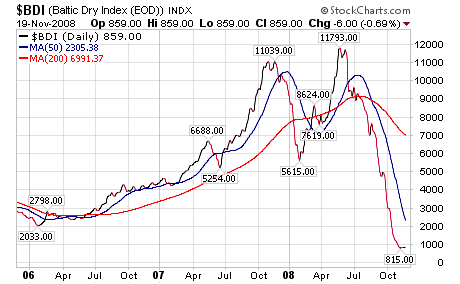

Two charts I come back to; the Baltic Dry Index (lower) and price of oil (top). A side note, I try to convert goods prices to goods flow in my head.
Fuel price is not the sole driver of shipping costs, but energy costs are a big driver of shipping customers, and their customers down the line. My take away is that retail customers, when sensitive to oil prices, give a useful clue to shippers.
My other take away is the double dip in the BDI, late 2007 and mid 2008. When shipping gets the double whammy, via oil, it becomes so volatile the marginal costs approached shipping price.
Another take are the dates, late 2007 it starts. The shipping markets makes a connection, it finds a coincidence, and codes a trade. By mid 2008, the shipping market is gonna jump all over the next oil peak. Markets code the events as repeatable, the economy attempts to respond to repeatable events with a multi-stage production line. Markets build encoders, they restore a flat noise channel after a distortion is revealed.
Look at the moving average line, 200 day, red line, on the BDI. That moving average matches one on the oil price chart, probably a 200 day also. Normally this tells me that an oil flow change in the retail sector will equilibriate out to the manufactures shipping flow in about 200 days. In both series, the data was collected on that day, by phone calls. That adjustment time is closely related to Ramsey theory, it concerns finding best approximations of a graph after reduction.
We became more efficient at shutting down transportation at or near oil price peaks the more often we practice, bad.
On a slightly related note, look at one of Mish's latest about municipal bankruptcies.
"As soon as a couple major cities declare bankruptcy to end burdensome union contracts and ridiculous pension promises, the stigma will be off and more cities will do it. Indeed, there will be a mad rush to do so, if the first few instances work out as well as I suspect."
Says Mish. He wants us to establish some efficiencies of scale regarding municipal bankruptcy.
2 comments:
nike 95
nike shoes
curry 5
yeezy boost 350
jordan shoes
yeezy boost 350 v2
off white nike
adidas gazelle
cheap nfl jerseys china
retro jordans
m5x30v5x37 y3s46m9g28 z5p78y5h93 d9m28z4b20 m5v96d4k07 t9v05m8t52
Post a Comment